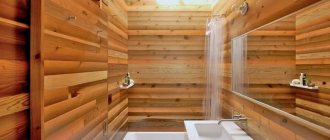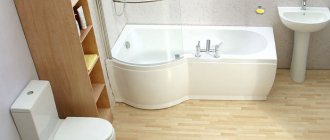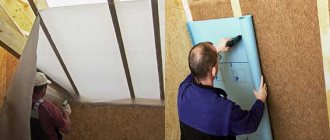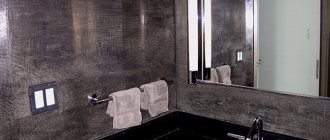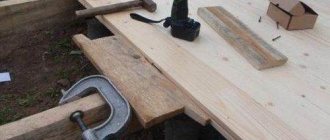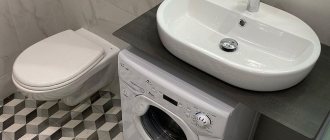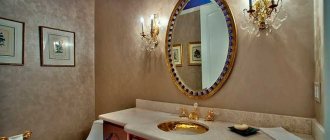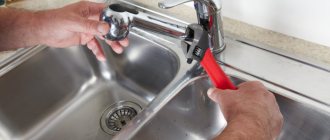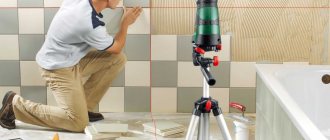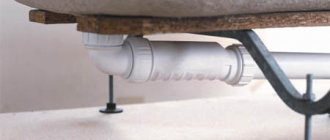Home / Ceiling design / Design solutions / Using decking boards in the bathroom
Bored by many, tiles and porcelain stoneware are now used most often in bathrooms. However, there are other coatings that can be used here for decoration. One way to create a unique design in the bathroom is with decking. It is rarely used to decorate the interior spaces of a house or apartment, but the unusual solution and properties of the material will allow you to get a very beautiful and completely unique interior.
Features of decking boards
Initially, such materials are not intended for finishing inside residential spaces. They are more suitable for decorating exactly that part of the home that gave them their name - terraces. However, if boards of this type can withstand harsh conditions outside the house, then they can also be successfully used inside if they have no contraindications. Fortunately, the coating does not have such disadvantages. There are two main types of decking boards:
- Made from real wood of special species that are resistant to moisture, do not rot and retain their external beauty under the most severe operating conditions.
- Artificially created boards from a mixture of wood and polymer resins. The resulting slats are not sensitive to cold, heat and, in general, temperature changes. Naturally, polymer parts are completely indifferent to the effects of water.
If the decking board in your bathroom must be natural, you will have to turn your attention to expensive types of wood - teak and its analogues. They all really cost a lot. Larch can reduce costs a little - it is also suitable for making coatings and has the necessary properties. The cost will be noticeably less, but the wood grain will also be less beautiful.
Artificial analogues of decking are the second name for such coatings. They will cost a little less and in terms of their characteristics are unlikely to be much inferior to real wood. At the same time, the composition of such coatings contains at least half the mass of wood, and the rest is polymers. Usually the ratio is even more attractive - up to seventy percent wood will be, and polymer resins will make up only thirty percent of the mass of the product.
Features of the premises' operation
Bathrooms and bathrooms always become rooms where a lot of problems arise during renovation or initial finishing. This is caused by the following features of the operating mode of these construction volumes:
- wet processes occur inside;
- since the bathroom, washbasin, toilet are not closed containers, there is a possibility of water splashing out of them if handled carelessly and this liquid gets on the finish of the walls, ceiling and floor;
- there is a possibility of flooding of the premises if the owners are forgetful;
- in addition to humidity, elevated temperature causes problems;
- Insufficient ventilation may occur, this is especially true for old buildings, the ventilation ducts of which are clogged and do not perform their functions.
Waterproofing in a bathroom in a wooden house
All these features lead to the fact that the materials used for finishing in the bathroom and toilet must meet the following requirements:
- low water absorption (inability to accumulate water, resistance to swelling);
- good waterproofing properties (especially important for a wooden house);
- resistance to elevated temperatures.
An additional requirement can be made for the floor: increased mechanical resistance.
It is also important to take into account that a wooden house has less mass than a brick or concrete one, so it is important not to overload the floors, and therefore the foundations, with excessively massive materials.
Tree
If you choose natural wood, you won't go wrong. The pattern on the floor surface will be very beautiful and, no less important, absolutely unique. In addition, by choosing a really expensive tree, you will get a coating that can last a very long time - species such as teak, merbau or rosewood can last up to a hundred years. Hardwood floors last less, but still for a very long time - up to twenty-five years.
The disadvantages of natural coating always include its high cost. However, even artificial decking cannot be cheap. Much more important is the fact that wood requires constant care. Wood can dry out, change its color when exposed to ultraviolet radiation, and wear out from mechanical stress. To avoid such consequences. The floors will have to be treated with a special impregnation or oil, and on the reverse side, before installation, all wooden elements are treated with antiseptic mixtures. The outside of the planks is coated with varnish to protect them from water.
Disadvantages of wooden flooring
Wood begins to warp from excessive moisture, and puddles in the bathroom cannot be avoided. In addition, few apartment owners have not encountered emergency leaks, and when children are splashing in the bathroom, it seems as if there has been a flood.
Since the floor in this room is used intensively, sooner or later stains from brilliant green, iodine, or a crushed tube of cosmetic product appear on it. Even if you scrape them off the surface of the wood, they cannot be completely removed.
Almost constant air humidity in the bathroom and temperature changes create a favorable environment for the growth of fungus and mold.
The owner will need to scrape the parquet for the bathroom regularly. In addition, it will not be possible to avoid black spots in corners and joints. Since wood actively absorbs odors, the “aroma” of the bathroom will be constantly present.
Polymer decking
WPC is a wood-polymer composite that can last you up to fifty years. At the same time, it does not have the main disadvantages characteristic of real wood: polymers will not fade, they are also not afraid of water, and it is much more difficult to damage durable parts than wooden ones. At the same time, such parts do not pose any health hazard - there is no release of harmful components.
The main drawback for many is its unprepossessing appearance. Still, this is not natural wood and this fact is very noticeable. If the cost of the material is comparable to inexpensive types of wood, then the appearance cannot be compared at all. The coating looks like boards, painted evenly and nothing more.
We arrange a wooden floor in the bathroom with our own hands
Despite the assurances of skeptics that a wooden floor in a bathroom is far from the best option, because these two components are incompatible, wood is being used as a floor covering in rooms with high humidity more and more often. And there are good reasons for this. The floor in the bathroom should be environmentally friendly, warm and breathable; is it possible to find a material other than wood that would fully meet these requirements? Hardly. Only wood can provide comfort, safety and “living” energy, which are so lacking in modern apartments.
Not all wood is suitable for bathroom floors.
How to assemble a structure
It’s worth immediately taking into account that the terrace board is mounted in the bathtub not directly on the concrete base, but on logs. This will force you to raise the level of the finished floor a few centimeters. Waterproofing is laid under the logs - welded, coated or rolled. It is important that water does not penetrate through it. A rough base is made of plywood or other moisture-resistant materials along the joists.
Some types of decking can be attached directly to the joists, skipping the process of laying the plywood base. In this case, special fasteners are used - clamps. It is better if the boards have grooves and tenons to connect them to each other - this will create a plane impenetrable to water. If a natural board is used, it is better to glue it to the base and a plywood subfloor will be necessary. Otherwise, the process of assembling the structure will be no more difficult than laying laminate and will only require care.
Advantages of wooden flooring
Nowadays, the latest technologies make it possible to make wooden floors in the bathroom. The advantages of such coverage are obvious:
- wood is a natural material and has natural warmth and absolute environmental safety;
- a wooden floor has low thermal conductivity, so there is no need to make a heating system for it;
- wood gives the room aesthetics;
- wooden flooring can be combined with other finishing materials, thereby creating an exclusive interior design.
Installation of support beams
Logs, wooden or metal, are used as a frame to secure the decking.
The support, made of aluminum, holds the flooring well and will last longer.
Wooden logs are cheaper, but cannot be combined with WPC boards.
When choosing this material for work, it is better to take larch bars with a humidity of no more than 25%.
Wooden elements will require additional treatment with an antiseptic; the ends are protected from cracking with solutions containing wax.
All methods of laying decking boards require a gap between the supporting joists and the foundation or soil of at least 4 cm.
Basically, the requirement is justified by measures to ensure unhindered air circulation under the flooring, which reduces the risk of floor deformation due to increased humidity.
The logs are located at the same level, forming a frame base of beams parallel to each other, the distance between which is maintained within 40-70 cm.
The greater the load on the floors being laid, the lower this value and the thicker the bars are chosen.
When forming the skeleton of the structure, keep in mind that the boards will be positioned perpendicular to the joists.
The connection itself is assembled using angles, straight and oblique, using galvanized and stainless steel screws.
Kinds
This material is divided into several types, depending on the manufacturing method and the components used.
Wooden
The main advantage of this material is its naturalness, but it requires special care, otherwise such a coating will quickly lose its shape and appearance.
The thickness of the boards ranges from 18-48 mm, so they can be used both in a private home and in public places.
Since this flooring is used outdoors, it is affected by sunlight, temperature changes and moisture, so only certain types of wood are used for its manufacture:
- oak;
- larch;
- ash;
- teak;
- merbau;
- rosewood;
- massaranduba.
Depending on the type of wood, the service life of such a coating will be different, if, for example, a larch decking board can last up to 25 years, merbau or massarandub up to 50 years, then teak or rosewood up to 100 years.
Before laying, it is recommended to treat the back side of the boards with an antiseptic, and coat the front side with oil or varnish.
It is recommended to treat natural wood decking boards with oil and wax 1-2 times a year.
Impregnated
The name of this material comes from the English word meaning saturation, because natural wood is impregnated with special compounds.
During this treatment, all fungal spores are removed from the wood, which allows its service life to be extended to 25-60 years.
Dimensions:
- the thickness of such a board can be from 26 to 45 mm;
- length from 2 to 6 m;
- width from 95 to 121 mm.
Impregnation reliably protects against rotting, but it cannot protect against mechanical damage. The advantages of such a decking board:
- when using paint and varnish coatings, they penetrate only into the top layer of wood and wear off over time, and in this case, the wood is completely impregnated , which significantly improves its characteristics;
- compositions that are safe for human health are used as impregnation;
- Pine is usually used as wood, which makes such material much cheaper than composite or natural from expensive types of wood;
- throughout the entire service life, no re-treatment is required;
- can be used both for flooring and for the construction of fences or other purposes.
As a disadvantage of impregnated boards, it should be noted that the impregnation is not colorless and therefore the color of the wood may be unnatural.
Under the influence of the sun, the greenish tint disappears after 2-3 weeks; some manufacturers cover the surface with varnish, wax or oil, or may add dyes to the impregnation.
Thermowood
Thermowood is obtained by treating boards with steam, the temperature of which is more than 200 degrees, but before that, moisture is removed from them. This wood perfectly retains its shape and does not absorb moisture, depending on the processing temperature, the color of the wood becomes golden or brown and it is not afraid of scuffs, since all the wood is painted.
In the house, thermowood can be laid in damp rooms, both on the floor and on the walls or ceiling; it can be used to make window sills. This coating goes well with a warm floor, but its heating should be uniform and not exceed 35 degrees.
Although the wood is steamed, it remains natural; if you make benches from it in a bathhouse, then resin will not enter into them, they will not heat up, and due to the density of the structure and the color impregnation of all the wood, it will not need to be sanded.
This wood can be used to decorate the outside of a house, to decorate steps or the floor on a terrace or porch. To reduce the slipping of the surface, it is enough to soak it in oil or you can buy corrugated boards.
Wood-polymer composite
Composite decking board (WPC) has two main components: wood chips or flour and polymer, a combination of these two materials, they complement each other perfectly and cover the shortcomings they have individually.
Polymer decking boards are not afraid of moisture, unlike wood; durable and not afraid of temperature changes, unlike plastic. This allowed manufacturers to create an almost ideal material that can be used both as outdoor flooring and to create fences or other structures. Allows you to do it yourself
The main advantages of WPC decking boards
- not afraid of temperature changes ranging from -500C to +700C;
- does not rot;
- not afraid of moisture;
- insects and rodents do not touch it;
- does not fade in the sun;
- will retain their original characteristics for 50-70 years;
- Regardless of weather conditions, it retains its size and shape.
To produce this material, wood flour is used, about 70%, 25% polymers and 5% polyethylene, dye and other additives. The components are connected at high temperatures, it reaches 2000C, after which the product is shaped using a press and finally the wood structure is pressed through.
The cost of a decking board made of wood-polymer composite will depend on the type of wood used (the finer the flour, the higher the cost), the quality of the stabilizers and dyes used. All this affects both the cost of the material and its strength, durability and wear resistance.
What other types of decking boards are there?
In addition to the differences in the manufacturing method, the terrace board can also be seamless; its installation is carried out using a tongue-and-groove connection. This allows you to make an almost monolithic connection, so moisture does not get on the base and eliminates the possibility of grass sprouting from the ground if the installation is carried out on the ground.
A seamless board, in turn, can be either solid or with internal voids.
The main advantages of seamless decking boards:
- beautiful appearance;
- simple installation that even a beginner can carry out;
- easy care;
- durability;
- high resistance to damage;
- does not fade when exposed to sunlight.
In order for such a surface to be comfortable and safe to walk on, it must have an anti-slip effect. To do this, during the manufacture of the decking board, corrugation is applied to its surface; to enhance the anti-slip effect, it can be additionally impregnated with oil.
Terrace boards made of natural wood, impregnated and thermowood have the structure of natural wood, and those made of wood-polymer composites have the wood structure applied during their manufacture.
Garden parquet
Garden parquet is intended for arranging terraces, paths or other outdoor coverings; it is based on a wood-polymer composite. In appearance, this coating is very similar to natural parquet, but surpasses it in its characteristics.
Garden parquet is made in the form of square tiles, which have a plastic base, and wood-polymer strips are placed on top.
Installation of this coating is very simple; no tools are needed for this, since the plastic bases are connected to each other using special locks.
Usually the dimensions of garden parquet are 30x30 cm, but it can be larger, and the thickness is between 22-35 mm.
Main advantages:
- not afraid of moisture;
- does not require annual maintenance;
- does not deform or rot;
- easy to install;
- the appearance cannot be distinguished from natural parquet.
Rules of care
Caring for solid wood or WPC flooring is not difficult, here are the basic rules of prevention:
- to remove snow and ice, you need to sprinkle the coating with salt and then rinse with water;
- rust can be removed using products containing oxalic or phosphoric acid;
- dirt is washed off with detergents and a hard, but not metal brush;
- It is better to remove greasy stains immediately with hot water and a degreaser;
- stains from berries, wine and red juices are washed off with hot water and bleach;
- ink stains can be removed with hot soapy water;
- The use of sand, abrasive detergents, metal brushes and scrapers to clean decking boards is contraindicated. They can scratch the surface and damage the protective layers of the slats;
- within a few months after installation, composite coatings become slightly lighter;
- dry cleaning, removal of leaves and debris is done using a brush.
Laying decking boards on the veranda is one of the most common options for using it in landscape design.
Deck fence
Another unexpected modern solution for a country house could be a fence made from deck boards. Different types of wood can be used to make deck boards, the most popular of which are larch and pine. At the request of the client, the board can be made of valuable wood. If independently calculating and ordering the required quantity of deck boards causes difficulties, our managers will always provide the necessary advice and make recommendations. You can contact the company either through the form on the website or by phone.
Wood in various aspects
- You can only place small wooden accessories in the bathroom, such as a shelf, hanger, soap dispenser, lamp or mirror frame. Even small details can change the character of the bathroom, making the environment feel more homely.
- If you want to emphasize the predominance of wood, use wooden furniture, but you should choose one made specifically for bathrooms. Ordinary wooden furniture will become saturated with moisture and quickly fail.
- Wooden plumbing fixtures – bathtubs and washbasins – look original and impressive. Special treatment makes them completely impervious to moisture, however, they are very expensive.
- Walking barefoot on cold tiles is a dubious pleasure. Therefore, bathrooms with wooden flooring are becoming more and more common.
- Wood can be used to make platforms and bodies, for example for a bathtub or shower tray.
- The interior of a wood-look bathroom can have a more expressive character if veneered boards are laid on the walls. With their help, you can create a single space with equipment, countertops and furniture. Exotic wood veneer is much more durable than wallpaper or paint and costs less than solid wood.
A white bathroom with partial wood or wooden furniture looks especially impressive (photo). Such an interior can become the embodiment of one of the modern styles: Scandinavian, contemporary, minimalism and even hi-tech.
This type of decking is considered the progenitor of building materials of this type, since it was this type that caused the growth in popularity of deck boards. Solid wood decking consists of ordinary boards made from solid pine, cedar, oak, and ash wood.
Materials for the device
Bathroom floors can be made of many materials, each of which has its own advantages and disadvantages. Below are the materials that are used for a wooden house:
- ceramic tile;
- tree;
- laminate;
- linoleum.
Ceramics
Technology for laying ceramic tiles on a wooden floor in the bathroom The most common material that is laid on the floor in the bathroom is tile. It is resistant to mechanical damage, does not absorb or allow water to pass through. In addition, the surface is easy to clean and does not cause problems during operation. If the floor needs to be laid in a wooden house, some difficulties may arise. Ceramics require a level, strong and stable base, which wood cannot provide. Most often, they find such a way out: a cement-sand screed is poured over OSB or wooden flooring, which will level the subfloor and increase its strength. The disadvantages of this method include:
- increasing the labor intensity of the process;
- the need to wait additional time for the cement to harden;
- increase in load on the floor.
The load is double, since the already heavy ceramics are supplemented by the weight of the screed.
Wood
It is important to note that pine or spruce, usually used in construction, will not be suitable in this case. To ensure durability and all the necessary characteristics, the floor in the bathroom of a wooden house must be made of the following materials:
- teak;
- beech;
- larch;
- thermotree;
- decking
Scheme of a wooden floor in a bathroom The first three materials belong to elite types of wood; they themselves have unique qualities that make them impervious to moisture. These rocks contain a high concentration of essential oils, which prevent the occurrence of rot, mold and mildew. The advantage of this flooring is its attractive appearance and presentability. But you need to prepare for serious financial costs, since such material is very expensive.
Thermowood has undergone heat treatment and is resistant to moisture
Thermowood is a natural material that has undergone heat treatment. The process involves applying steam to the wood at a temperature of 240 degrees Celsius, while limiting the access of oxygen.
This method allows you to achieve the following results:
- the ability to warp when exposed to moisture is reduced;
- the ability to absorb water is reduced by 5 times;
- Antiseptic properties increase 10 times (resistance to fungi, mold and rot).
Decking combines the properties of wood and polymers. It is resistant to moisture and mechanical stress. A fairly new material on the domestic market is decking. It has several other names: decking board, wood plastic. This material combines the properties of wood and polymers and is resistant to moisture and mechanical stress. Originally intended for creating flooring on terraces, swimming pools and on ship decks. Due to its properties, it can also be laid on the floor of a bathroom or toilet in a wooden house. Has an attractive appearance.
Laminate
There is only one requirement here - moisture resistance. This property must be specified by the manufacturer. If you lay a material that is not resistant to water on the bathroom floor, it will quickly collapse and require repair. Even a laminate of the highest class in terms of strength does not guarantee a good result if it is not marked “moisture resistant”. In some cases, it is more rational to turn to other types of flooring for a wooden house.
The main quality of laminate in the bathroom is moisture resistance
Linoleum
It is worth putting linoleum on the bathroom floor if you are short on money. This material will cost less than all others and has the necessary moisture resistance. In addition, the advantage is that, unlike ceramics, linoleum is a warm material, so there will be no problems during its operation.
It is better to choose commercial types of linoleum - they are more wear-resistant. The following advice can be given: choose commercial types of linoleum. These coatings are intended for use in rooms with large crowds of people, therefore they are designed for heavy loads and are characterized by high wear resistance.
If you put such material on the floor of a wooden house, you can guarantee that it will last a long time.
In addition, material manufacturers now offer a fairly wide range of attractive models.
Until recently, wood was not a material often used in bathroom design. However, new technologies for wood production and preservation, as well as the availability of suitable wood varieties, have led to a change in trends. Furniture, a wooden bathtub, and wooden trim will bring an atmosphere of warmth, lightness, charm and harmony to the bathroom and will allow you to decorate it in such original styles as country, Provence, contemporary, Scandinavian, eco-style.
Some tips
To make a high-quality floor in a wooden house, you should consider a few tips:
- For new construction and the use of ceramic tiles, it is rational to design in wet rooms floors on metal beams with subsequent pouring of monolithic reinforced concrete. This design will allow you to lay screed and tiles without fear.
- If there is no desire to use metal or during major renovations in the house, it is recommended to reduce the pitch of the floor beams. In the room where the ceramics will be laid, load-bearing beams are laid more often, which reduces the load on each of them.
